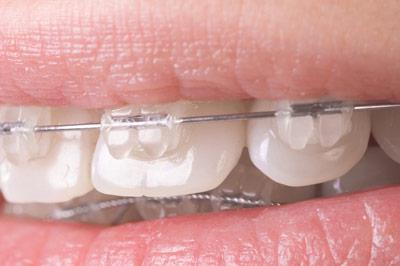Distal occlusion
There are several types of malocclusion,but the most terrible of them is the distal bite. In people with this disease, the upper jaw strongly hangs over the lower one, besides, it is more developed. Visually, it seems that the patient lacks a chin - it is too small in comparison with the size of the upper jaw.
Typically, the distal occlusion is genetically affectedpredisposed people to this disease. However, this bite often occurs if a child is accustomed to sucking fingers from childhood and also having problems with the back and nasopharynx, because in these cases the upper jaw develops faster than the lower one, which is why the distal bite appears.
In mild cases of disease, patients and notthink that the outline of their face is changed because of the bite and do not relate to this as a problem. However, it is desirable to correct the bite, since it not only distorts the face, but also provokes rapid tooth decay. If the patient still decided not to treat the distal occlusion, then the following problems can await him:
1. The posterior teeth can quickly collapse because of the increased load on them;
2. Over time, swallowing will become more and more difficult;
3. The appearance of gum disease and, as a consequence, tooth loss;
4. Pain during chewing food, which with age will become stronger.
Distal occlusion: treatment
Cure the disease in the early stages is notespecially difficult - it is enough to install braces or other similar systems to correct the bite. If the disease has developed too much, and you can no longer fix the bite by the braces, the patient will have to agree to a surgical intervention. However, correcting the distal occlusion will require the use of additional devices.
The orthodontist examines the patient and, based oncauses the occurrence of such a bite, appoints the appropriate treatment. If the upper jaw is too developed, it is necessary to reduce it, for example, by removing some molars. If, on the contrary, the lower jaw is underdeveloped, then a course of treatment is prescribed for its development.
Correcting the distal bite is best during adolescence, but after all the milk teeth have changed to indigenous ones. To do this, use plates, trainers, dental trays.
In adulthood, braces andMyostimulation of the lower jaw is carried out. This procedure allows for better development of facial muscles, which will help to push forward the lower jaw. It is also necessary to develop chewing muscles and muscles, with which the lower jaw is set in motion. Sometimes a face arc is used. With the overdevelopment of the upper jaw must necessarily remove several molars. Fully treatment takes three years, and it is also necessary to undergo maintenance therapy for another five years. During this time, the bite will gradually be corrected.
In order to prevent the development of distalbite, you need to follow a few simple tips, while the child is still small. First of all, you should wean him to suck a finger if he does it. Most often this harmful habit causes an incorrect bite, and not necessarily distal. It is also important to eat the right baby - in the diet must be present foods with a high content of vitamin D and calcium. It is necessary to give the baby a solid food for the development of masticatory muscles. It is useful to be in the sun a lot. In addition, you need to regularly visit the doctors and on time to cure the diseases of the nasopharynx. It is equally important not to allow the curvature of the posture, which can lead to the development of an incorrect bite. If you comply with these rules, the child will form a proper bite.
</ p>>






